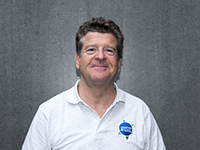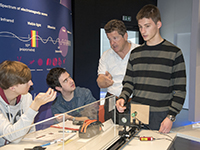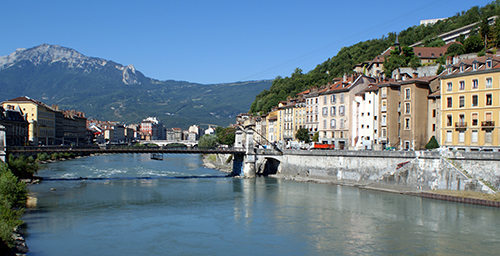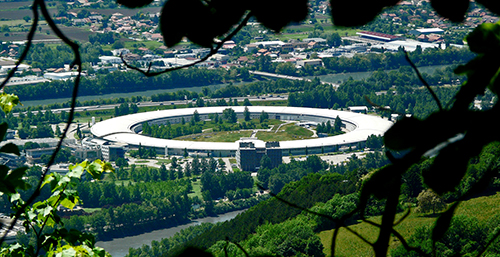Bruno Pin: a lifetime of sharing knowledge Inspire article
Bruno Pin can go a long way to find new methods of making science meaningful to his students.

Image courtesy of ESRF
Solving mysteries, revealing insights into medicines or attempting some trendy molecular cooking are examples of what Bruno Pin and his students get up to in his science lessons. Obviously his classroom is not always like this, but Bruno likes to find new ways to make science meaningful to his students.
A secondary school teacher for the past 27 years, Bruno Pin always knew he wanted to teach. He loved teaching tennis in the summer as a teenager and went on to study physics. He wasn’t persuaded by a career in research (unlike his wife, whom he met at university), so he took the exams to become a teacher straight after completing his degree. Exchanging views, sharing knowledge and interacting with youngsters drive Bruno in his job. He claims that “the difficulty and, funnily enough, also the charm of this job is that you don’t have two days that are the same”.

group of students at ESRF
Image courtesy of ESRF
Bruno has always used a creative approach to teaching. He has been involved in setting up local programmes in Grenoble such as Nano@School and, more recently, Synchrotron@School the ESRF’s outreach programme for secondary school students. These initiatives often started with an informal conversation with researchers from the different labs in the area and from visits to his school, the Lycée des Eaux Claires. With time these programmes became properly established under the umbrella of the Academie de Grenoble, the local representative for the Minister of Education. The focus of these initiatives is to give students the opportunity to get out of the routine of the classroom and experiment with science at the same time.
“Ultimately,” Bruno says, “I want to share knowledge with the students. These programmes are a different take on teaching; we are trying to transmit concepts and ideas to show them how science can be applied to everyday life.”

Image courtesy of Olivier Duquesne; image source: Flickr
Evolution of teaching throughout the years
Like many teachers, at the age of 54 Bruno Pin has seen first-hand the evolution in different generations of students. “Maybe it is because there is a bigger gap in age between me and the 17–18-year-olds that I am teaching today, but I also feel there is a change in how they learn,” he explains. “Take, for example, maths. For me it is a tool to use every day, not just a subject in school, but students don’t understand this and therefore can’t make calculations in their heads. And they don’t even know how to use a calculator properly, so there is a learning gap compared to some years ago.”
The fact that kids today have fast access to communication means they are more “awake”, as Bruno calls it. They ask many questions, have a lot of curiosity and are more experimental than previous generations. On the other hand, he claims that students “need answers straight away” and “don’t think things through as much as in the past”.
Science path by default
Going down the scientific route in France has always been seen as the ‘prestigious’ pathway. At the age of 16, children have to choose what subjects they want to specialise in for the last two years of school. Many students are unsure about their choice, and parents sometimes orientate them towards the scientific option because it is taken for granted that they will find a job later on. Bruno points out that a scientific option involves many years of studying (especially if the student does a PhD) and it is very demanding, so you need to be committed: if you make the wrong choice at 16, then you might fail later on if you can’t keep up with the workload. Bruno has witnessed some people failing, but others – most of them, in fact – have gone on to become professionals in their field. He says this proudly and explains that he often asks former students who are now doctors or engineers to visit his school to show youngsters how far you can go with science. And their journey invariably started in a classroom with Bruno at the teacher’s desk.
Synchrotron@School: making science tangible
While bringing scientists into the classroom is a good way to demystify scientific careers, Bruno also knows that changing students’ views on research in general takes a bit more work, for example, by changing the educational setting and taking them into research facilities. He was nominated by the Academie to direct school outreach activities at the ESRF, together with Yannick Lacaze, an outreach officer at ESRF.

Image courtesy of Garry
Knight; image source: Flickr
The concept of the synchrotron may not mean much to many students in secondary schools in Grenoble. In an attempt to explain how a synchrotron works, to present the various fields of research conducted in an international facility such as the ESRF, and to show the diversity of jobs available (such as scientists, engineers and technicians), the ESRF has organised, along with the Academie de Grenoble, a series of one-day stays at the facility since 2013.
The day starts with a challenge for each group of students. Throughout the day they need to find the solution to a question based on the science curriculum and the work done at the ESRF. Currently most questions revolve around diffraction, fluorescence and heat transfer. For example, students need to identify a fluorescent molecule in a test tube. They use everyday objects, such as bank notes or reflective vests, to learn about the emission spectrum of different fluorescent and phosphorescent powders. Then they calculate the energy emitted by the unknown molecule and compare it with supplied data to find its name. At the end of the day the students present a poster and a slideshow highlighting their conclusions. The day also includes a visit to the beamlines and informal chats with staff to allow relaxed exchanges of views and advice.

Image courtesy of DKdlV; image source: Flickr
Synchrotron@School
Launched in 2013, Synchrotron@School is now well established among local schools and has also welcomed secondary school girls from abroad, namely the UK and Sweden, with the aim of promoting careers for Women in Science. The programme is for students in the last two years of school before university. If you would like to apply, please contact Yannick Lacaze: yannick.lacaze@esrf.fr
Resources
- Visit the Nano@School website to learn more.
Institutions
Review
Atomic physics is for the most part theoretical in high school because the experimental part requires too much expensive support and equipment. Instead, Bruno Pin goes with students in a research centre, where the experiments can be done and so the students become researchers for a day.
Corina Toma, “Tiberiu Popoviciu” Computer Science High School, Romania





